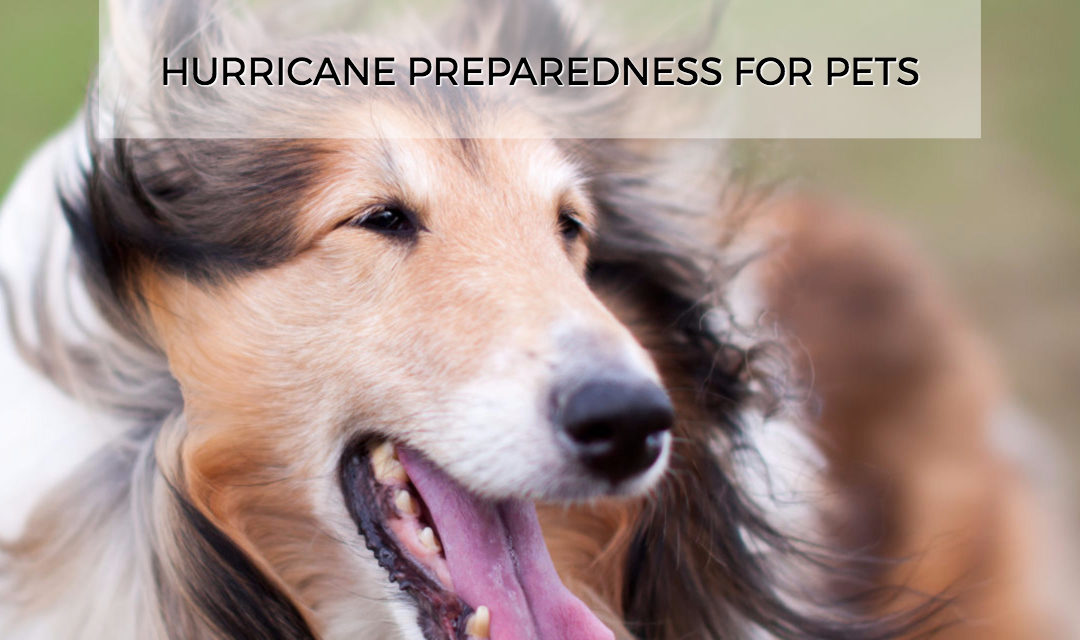Hurricane Preparedness for Pets
For many people, June 1 might mark the beginning of summer, but for those of us who live in Florida, it marks the beginning of another hurricane season. Each June I pull out our hurricane kit to ensure we have plenty of batteries and flashlights and emergency radio and other types of lights. I also get our generator serviced and make a trip to Sam’s for a supply of bottled water.
In addition to planning for the people in my family, I also plan for my pets by creating an emergency kit for my dogs.
Emergency Kit for Dogs
I keep the following items in my emergency kit so we can evacuate at any time:
- Sturdy leashes, harnesses and/or carriers to transport pets safely and ensure that they can’t escape.
- Food, drinking water, and bowls.
- Medications and copies of medical records stored in a waterproof container or bag.
- A first aid kit.
- Current photos of me with my pet(s) in case they get lost. Since many pets look alike, this will help to eliminate mistaken identity and confusion.
- Information on feeding schedules, medical conditions, behavior problems, and the name and number of your veterinarian.
- Pet beds and toys, if easily transportable.
Keep items in an accessible place and store them in sturdy containers so that they can be carried easily.
Also, be sure that your pets have tags with your phone number on their collars, they are microchipped and the microchip information is up to date. This is extremely important because after each hurricane hundreds of pets are found, with no way to notify the owners.
Emergency Plan for Your Pet
In addition to an emergency kit of your pets, you also need an emergency plan should you have to evacuate quickly. Here is the outline of a plan I created for my own dogs.
Step 1: Know a Safe Place to Take Your Pets
Arrange a safe haven for your pets in the event of an evacuation. DO NOT LEAVE YOUR PETS BEHIND. Remember, if it isn’t safe for you, it isn’t safe for your pets. They may become trapped or escape and be exposed to numerous life-threatening hazards. Most shelters do not accept pets, so it is imperative that you have determined where you will bring your pets ahead of time:
- Contact your veterinarian for a list of preferred boarding kennels and facilities.
- Ask your local animal shelter if they provide emergency shelter or foster care for pets.
- Identify hotels or motels outside of your immediate area that accepts pets.
- Ask friends and relatives outside your immediate area if they would be willing to take in your pet.
Step 2: Prepare Emergency Supplies and Traveling Kits
If you must evacuate your home in a crisis, plan for the worst-case scenario. Even if you think you may be gone for only a day, assume that you may not be allowed to return for several weeks. When recommendations for evacuation have been announced, follow the instructions of local and state officials. Regardless of whether you decide to ‘ride out the storm’ or evacuate, here are some items you should consider:
- Make sure all pets wear collars and tags with up-to-date identification information. Your pet’s ID tag should contain his name, telephone number, and any urgent medical needs. Be sure to also write your pet’s name, your name and contact information on your pet’s carrier.
- We recommend microchipping your pet as a more permanent form of identification. A microchip is implanted under the skin in the animal’s shoulder area and can be read by a scanner at most animal shelters.
- Always bring pets indoors at the first sign or warning of a storm or disaster. Pets can become disoriented and wander away from home in a crisis.
- Store an emergency kit and leashes as close to an exit as possible. Make sure that everyone in the family knows where it is, and that it is clearly labeled and easy to carry. Items to consider keeping in or near your “Evac-Pack” include:
- Pet first-aid kit and guide book (ask your vet what to include)
- 3-7 days’ worth of canned (pop-top) or dry food (be sure to rotate every two months)
- Disposable litter trays (aluminum roasting pans are perfect)
- Litter or paper toweling
- Liquid dish soap and disinfectant
- Disposable garbage bags for clean-up
- Pet feeding dishes and water bowls
- Extra collar or harness as well as an extra leash
- Photocopies and/or USB of medical records and a waterproof container with a two-week supply of any medicine your pet requires
- At least seven days’ worth of bottled water for each person and pet (store in a cool, dry place and replace every two months)
- A traveling bag, crate or sturdy carrier, ideally one for each pet
- Flashlight
- Blanket
- Recent photos of your pets (in case you are separated and need to make “Lost” posters)
- Especially for cats: Pillowcase, toys, scoopable litter
- Especially for dogs: Extra leash, toys and chew toys, a week’s worth of cage liner
Hopefully, we will not have a hurricane this year, but if we do this post can help with hurricane preparedness for pets.





Recent Comments